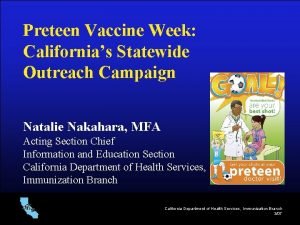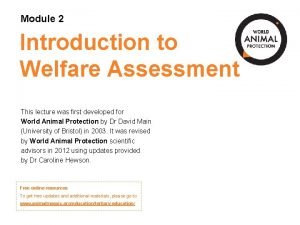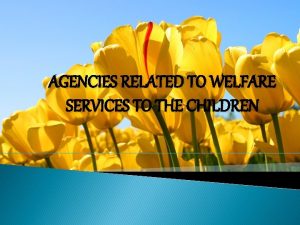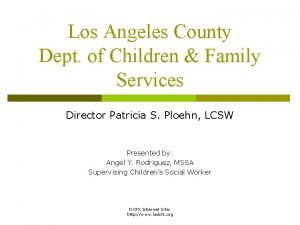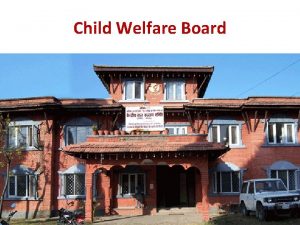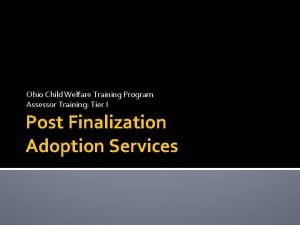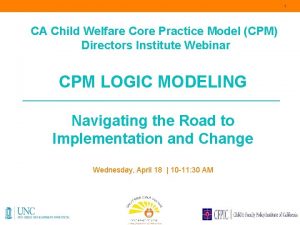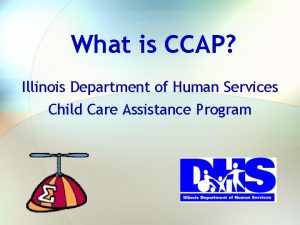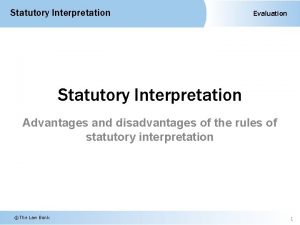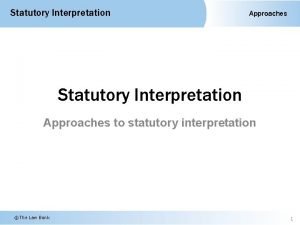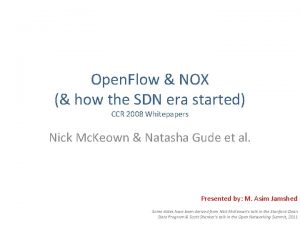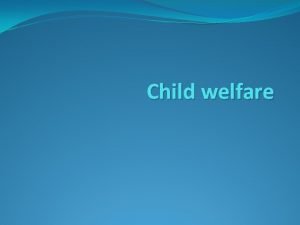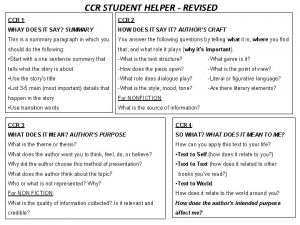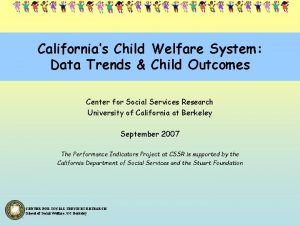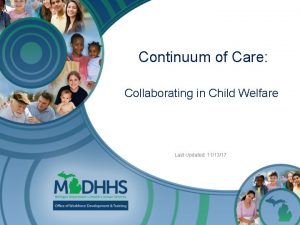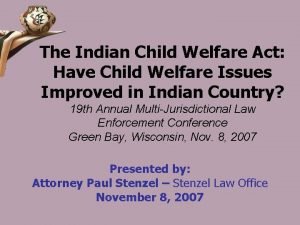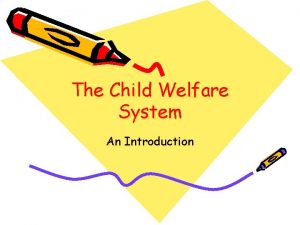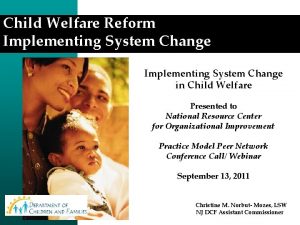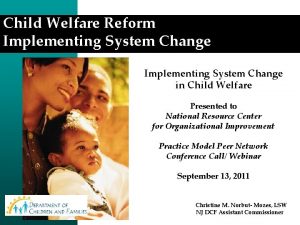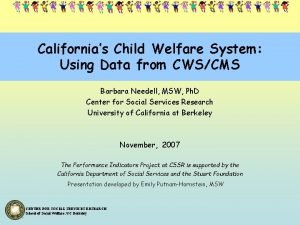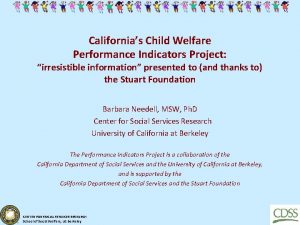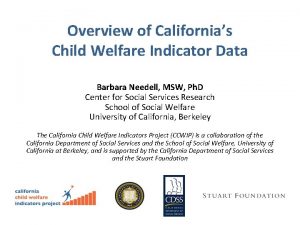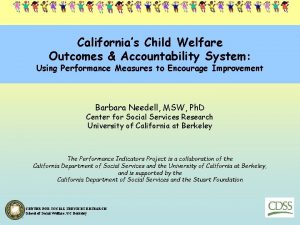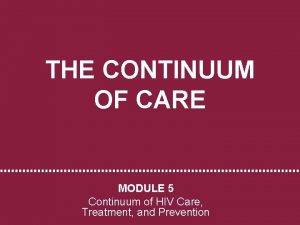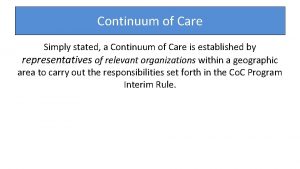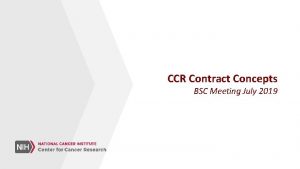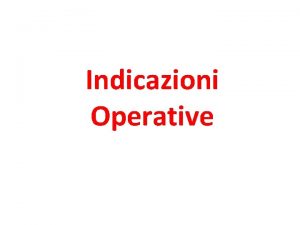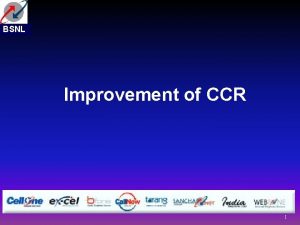Californias Child Welfare Continuum of Care Reform CCR





















- Slides: 21

California’s Child Welfare Continuum of Care Reform (CCR) Overview California Department of Social Services January 2016

Background Legislative mandate*: • Reform Group Homes and Foster Family Agencies with robust and diverse stakeholder input • Legislative report with recommendations Builds on previous reform efforts: SB 933, RBS Reform Continuum of Care Reform: A comprehensive framework that supports children, youth and families across placement settings (from relatives to congregate care) in achieving permanency. Includes: Increased engagement with children, youth and families Increased capacity for home-based family care Limited use of congregate care Systemic and infrastructure changes: rates, training, accreditation, accountability & performance, mental health services * Senate Bill 1013 (Chapter 35, Statutes of 2012)

Vision • All children live with a committed, permanent and nurturing family • Individualized and coordinated services and supports • Focus on permanent family and preparation for successful adulthood • When needed, congregate care is a short-term, high quality, intensive intervention that is just one part of a continuum of care available for children, youth and young adults

Guiding Principles • The child, youth and family’s experience is valued in: – Assessment – Service planning – Placement decisions • Children shouldn’t change placements to get services • Cross system and cross-agency collaboration to improve access to services and outcomes • Recognizing the differences in the probation system and among other groups of youth

DRAFT Proposed CCR Implementation Framework Stakeholder Implementation Advisory Committee State/County Implementation Team CDSS, DHCS, CWDA, CPOC, CBHDA, CSAC County Representatives Providers, Youth, Caregivers, Tribes, Advocates, Counties, Legislative Staff and others CCR Implementation Workgroups Therapeutic Residential Services Settings/FFA Program & Licensing Rate Structures Accountability Framework RFA Implementation Training Deliverables Program Instructions • Regulations • ACLs/CFLs • Forms Capacity Building Activities • Outreach Activities • Communication Materials • Training Curricula • Mental Health Certification Accountability & Oversight Framework • Accreditation Process • Application review process • Provider Performance measures • Consumer Survey Rate Structure • New Therapeutic Residential Services Settings & FFA rates and rate structures

The “Paradigm Shift” Group Home Therapeutic Residential Services Settings (aka STRTC) Children who cannot be safely placed in a family can receive short-term, residential care with specific care plans and intensive therapeutic interventions and services to support transition to a family.

Foster Families Resource Family Approval: Foster Family Adoptive Family Relative Caregiver • Related and non-related families • Training for all families • Resource Families still choose the role they play in the system: temporary or permanent • Prepared for permanency-no additional approvals necessary RFA Process: Resource Family • Single, unified RFA process will be used for all caregiver families: kin, NREFM, county foster families, FFA foster families • Avoids need for adoption home study and second, more in-depth background check; once approved, families can adopt or become kinguardians

The Goal: Children in Resource Families Children in Congregate Care Permanent Family

Increased Engagement • Child & Family Team(CFT) • Up-front and continuing assessment along common domains • Aligns with the California Child Welfare Core Practice Model (Statewide Practice Model) & Pathways to Wellness (Katie A. settlement)

Building Family Care Capacity Existing efforts to improve and increase the capacity of home-based family care: • Quality Parenting Initiative • Resource Family Approval Process • Approved Relative Caregiver (ARC) Funding Option Program (2014: $30 million investment) • Tribally-approved homes/Tribal access to background information

Increasing Capacity for Home-Based Family Care • Resource family approval by counties, Foster Family Agencies (FFAs) and Therapeutic Residential Services Settings • Funding for support, retention, recruitment and training of resource families & relatives • Foster Family Agencies provide Core Services: – Trauma Informed – Culturally relevant – Accreditation through COA, CARF & JCAHO – May provide core services to children in county approved families and relatives • Updated and expanded training requirements across provider and caregiver categories

Limited Use of Congregate Care • Transition County Shelter Temporary Shelter Care Facility • Group Home Therapeutic Residential Services Settings that provide Core Services: – Trauma Informed – Culturally relevant – Capacity to transition to children to family care by approving resource families

Meeting the needs of Probation Youth: • Collaboration and coordination will be necessary in order for CCR to be successful for Probation Youth. • Identify the training and supports families need to parent probation youth in FFAs and for Therapeutic Residential Services Settings to develop programs targeted at probation youth. • Programs developed and/or maintained for probation youth who are in need of substance use disorder treatment, sex offender treatment and behavior modification programming. • After-care services as a central component to ensuring a youth’s successful and sustaining transition back into his/her family home.

Meeting the needs of Probation Youth: Extensions for Probation Youth are linked to the progress tied to specific benchmarks. In the year ahead the CDSS will be: • Engaging FFAs and other community based organizations to develop strategies to recruit and support specialized foster homes. • Defining outcome measures to be collected analyzed to assess implementation of CCR and the impact on Probation. • Working with Providers, Courts and County Probation Departments to develop capacity for home-based family care. • Working with Therapeutic Residential Services Settings to address treatment needs of specific Probation populations.

Core Services FFAs and Therapeutic Residential Services Settings make available core services either directly or through formal agreements: • Access to specialty mental health services • Transitional support services for placement changes, permanency; aftercare • Education, physical, behavioral and mental health supports • Activities to support youth achieving a successful adulthood • Services to achieve permanency & maintain/establish family connections • Active efforts for ICWA-Eligible children

Oversight, Accountability & Provider Performance Measures • National Accreditation • Cross Departmental Oversight Framework • Evaluate provider performance along common domains • Youth, caregiver and stakeholder satisfaction surveys • Public transparency of provider performance

Accreditation: FFAs and Therapeutic Residential Services Settings • Accreditation will be accepted from: – Joint Commission on Accreditation of Healthcare Organizations (JCAHO) – Commission on Accreditation of Rehabilitation Facilities (CARF) – Accreditation through Council on Accreditation (COA) CDSS is engaging with agencies and will continue to address specific needs of the State, Counties, and Providers regarding accreditation and CCR requirements.

New Provider Rate Structure • New provider rate structure: – Sunset RCL system (1 -14) *A single Therapeutic Residential Services Settings rate (IV-E) *A tiered resource family care rate structure based on level of need for the resource family and resource family agency *Therapeutic Residential Services Settings rate will not be blended with Title XIX (rates for mental health services is status quo) *Therapeutic Foster Care Rate (Katie A) • Multi-year implementation: – New requirements take effect 1/1/2017 – Provisions for extensions up to two years – Additional extensions for providers and longer for those serving probation youth • Therapeutic Residential Services Settings and FFA may be public or private. • Design a new program audit that aligns with required program and treatment competencies and accreditation standards; coordinates program, fiscal, and health & safety reviews (DHCS, CCLD, CDSS).

The Work Ahead… Will take “a village”! 1 -1 -17 CDSS will be collaborating with a wide array of stakeholders in the implementation work AB 403 CCR Report Preparation • Policies • Rates • Outreach • Orientations • Tools • Training • Accountability • Recruitment • Performance measures Pre-Implementation • Applications • Reviews • Licenses • Mental Health Certification • Data testing • Training & TA Implementation: Children & families served differently! • Extensions • Data collection • Monitoring • Technical Assistance • Policy Revision

Provider Licensing • CDSS Community Care Licensing (CCL) will review applications for group homes transitioning to “STRTCs”. • Applications for licensing will include the Plan Of Operation/Program Statements and licensing forms that need to be updated. • Provisional licensure may be issued in order to secure accreditation. • Providers will submit an application with revisions of the updated Plan Of Operation/Program Statement to their local CCL Regional Office.

Questions and Contact Info • Questions can be sent to: ccr@dss. ca. gov • Additional information on the CDSS website at: http: //www. cdss. ca. gov/cdssweb/default. htm
 Continuum of care reform
Continuum of care reform Grade californias vaccine
Grade californias vaccine 4 regions of california
4 regions of california Animal welfare continuum
Animal welfare continuum Child protection reform amendment act 2017
Child protection reform amendment act 2017 National programmes related to child health and welfare
National programmes related to child health and welfare National child policy 1974
National child policy 1974 Child welfare services and agencies
Child welfare services and agencies Welfare agencies
Welfare agencies Children and family services los angeles
Children and family services los angeles Central child welfare board
Central child welfare board Ohio child welfare training program
Ohio child welfare training program Child welfare
Child welfare Vr3 child welfare foundation
Vr3 child welfare foundation California child welfare core practice model
California child welfare core practice model Level of care primary secondary tertiary
Level of care primary secondary tertiary Care welfare safety and security
Care welfare safety and security Ccap illinois
Ccap illinois Poder judicial
Poder judicial Golden rule advantages and disadvantages
Golden rule advantages and disadvantages Purposive interpretation
Purposive interpretation Nox network
Nox network

